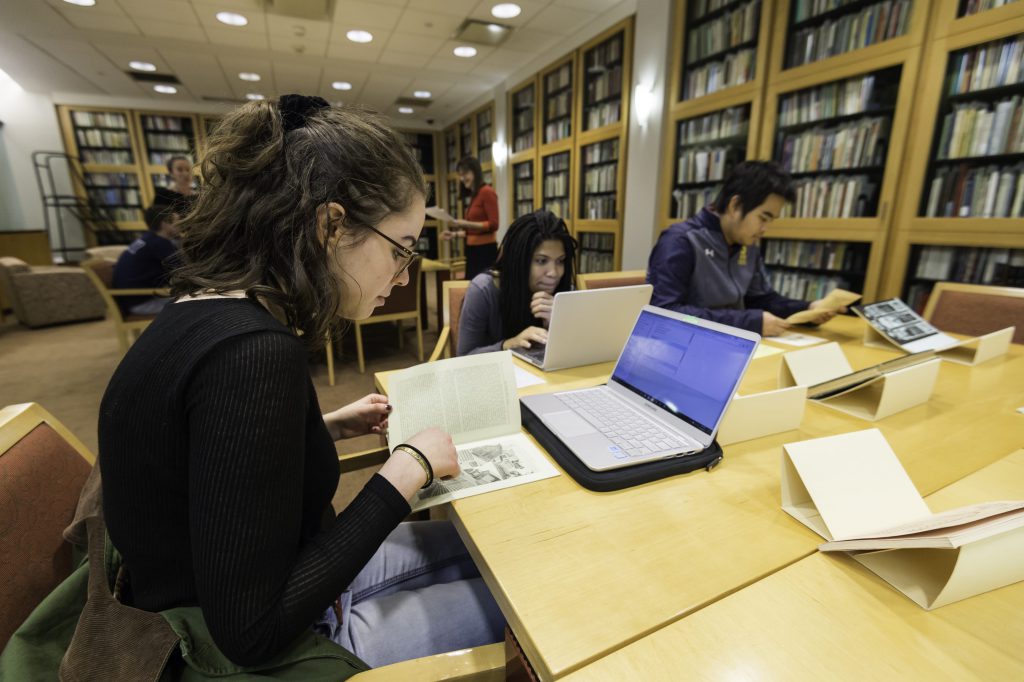by Emily Tworek, Class of 2020
When you think of research, what do you picture? People in white lab coats? Chemical reactions and poster presentations? While that’s part of the research students can do at Rochester, there’s another world of research opportunities available for students interested in the social sciences and the humanities. I sat down with Joan Rubin, Dexter Perkins Professor of History and the Ani and Mark Gabrellian Director of the Humanities Center to talk a bit more about research opportunities for students interested in the humanities.

Emily: What does research in the humanities “look” like?
Joan: Research can be archival, meaning that you would go to a repository where there are people’s letters, or manuscripts, or other kinds of published or unpublished documents, and you read them, analyze them, and put them together to make an argument of your own. Research can also involve digital products, we have many digital projects on campus students can participate in—the Seward papers is one, which involves materials in our Rare Books and Special Collections. Research can also be “reading and thinking.” In these kinds of projects, there may be a quantitative dimension to your research, but there may not be. You may be thinking about the “big questions” of human life and reading what others have had to say about that, and coming up with your own interpretations. These are just a few examples!
E: How many humanities departments or students are doing research right now?
J: I would say all of the humanities departments are doing research right now. In the Humanities Center, we have eight “core” departments, which include the humanistic social sciences of history and anthropology, art & art history, English, modern languages and cultures, music, philosophy, and religion & classics. The divisions are not clear cut though, for example, the linguistics department has a lot of humanistically-geared research going on. Of the departments represented in the Humanities Center, though, everyone is supporting research in some way.
The bulk of undergraduate research happens through courses, but some of the projects that faculty members are doing use undergraduate students outside the classroom. In the history department, for example, we have the History Opportunities for Undergraduate Research (the HOUR program), which enables undergraduate students to work on faculty projects and get paid or receive credit for their work.
E: How would undergraduates interested in the humanities go about pursuing their own research?
J: There are two main programs that support undergraduate research in the humanities, and those are the HRIG program and Meliora Scholars. The HRIG (Humanities Research and Innovation Grant) is awarded upon admission for incoming first-year students to use during their four years to do research in the humanities. The Meliora Scholars program also provides $3,000 of funding to do research in the humanities. It’s aimed towards second semester first year students, who may already have a bit of an idea about what interests them. It’s different from the HRIG program in that students in Meliora Scholars make a commitment to attend some programs in addition to their research. These can include going to a guest speaker’s presentation, meeting with a guest speaker in the Humanities Center over an exclusive coffee hour, or going to a lecture organized by a faculty member. There are twenty incoming Meliora scholars who were just selected this spring, and a set of new mentors to work with them, we’re all very excited about this program.
E: Could you tell me a bit about some of the projects and research happening right now?
J: Professor Jarvis currently is working on a partnership with the University of Ghana, and they’re doing archaeological work and working in a digital space to make digital models of some old structures in Ghana, and he takes undergraduates with him when he goes to Ghana.
There’s also a student who is interested in the origins of a totem pole that was at her high school, and whether it even is a real totem pole. She doesn’t think it even has anything to do with the indigenous population where her high school is, and she’d like to do an investigation of the totem pole, find out how it got to her high school, and see if she can actually figure out where it should be and maybe even repatriate it. She’s very interested in how this artifact got to be planted in a very different space from where it belongs. Another student who is researching the children of Holocaust survivors and eating disorders. It’s somewhere between anthropology and women’s and gender studies. There’s also a student interested in creative writing who is originally from Alabama. Over the summer, she’s going home and visiting civil rights sites and museums in Birmingham. Using her experience, she wants to write short stories and make that the creative background for her project.
E: What should prospective students know about the Humanities Center?
J: We have, in the Humanities Center, a place that can be the source of a sense of community for students, that’s the chief goal for our services for undergraduates. We don’t want students to feel that they must be a lonely scholar working away in an attic on their research–you can meet others interested in similar things through the Humanities Center. It can be as simple as studying together, going to a Meliora Scholars lunch, or going to an event. We consistently host visiting speakers that students can meet and maybe get some ideas about their research projects and we also host career-oriented events through our partnership with the Gwen M. Greene Center.
Next year, we’re hoping to do more student-initiated evening events in the center, many of them arts-focused. That can be a dance performance, a music performance, etc. We are always looking for ways to support students in the humanities. This is a great time to study humanities at the University of Rochester, because things are really on the move.

